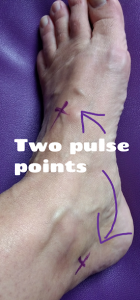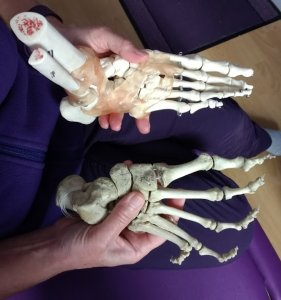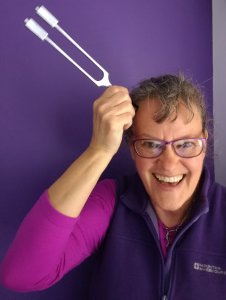I didn’t know
Things I didn’t know before my podiatrist told me
Recently, I conducted a poll among my Podiatry colleagues asking what was the most common response to: “the things I didn’t know before my podiatrist told me” statement. You might be interested in the answers, here’s the top 5 of 20:-
I didn’t know I had pulses in my feet!

Yes, you have two pulses in your feet that we typically check when you come to see us. First, on the top of your foot and another behind the inside of your ankle bone. Why do we check them? Because we want to know you have a regular, steady pulse with no odd blips that could indicate an irregular heart beat or atrial fibrillation (a heart condition that can increase your risk of stroke by 5 times). Sometimes this might be the first noticeable symptom picked up on our routine check here at the clinic. We can get you some help with it promptly. #Newsflash, the body is all one unit, not just a pair of feet, we want to make sure the rest of you is in fine fettle too!
We look at other things to do with pulses too, but that’s a whole blog of its own that I will write another time.
I didn’t know I had vibration sensation in my feet
When you first come to see us, we typically do a set of tests on your sensory abilities, one looks at vibration which we test with a tuning fork on your joints. Why is this important? Because vibration, felt through the receptors in your joints, is one of your feedback mechanisms that helps your brain to know where your body is in relation to the space around it. Its really important in maintaining balance and it is known to deteriorate as we get older, say around 65+. This is one of the reasons people get more prone to falling as they age into their 70s-80s.
[side thread, if you put a vibrating tuning fork on your head you can hear the sound through your skull- I let the kids have a go at this when I give school talks, they love it!]
I didn’t know you needed to know the medication I take; why is that? it’s got nothing to do with my feet surely?
This is such a common reaction, but lets play it out. Suppose you take anticoagulants because you have a heart condition or ‘sticky’ blood, the Clopidogrel, Warfarin or even Aspirin is going to stop it clotting in ‘normal’ time. If you had an ingrown toe nail that needed operating on it would bleed…a lot! Better we know about that beforehand wouldn’t you say?
Lets imagine you have long standing asthma or rheumatoid arthritis which means you have had years of cortico-steroid/prednisolone medication to help you breathe or reduce joint inflammation. One of the side effects is thinner, fragile skin, we have to be super careful not to damage it. I’d say that’s worth knowing about.
My medical history! I didn’t know you needed to know that; what has that got to do with my feet?
Maybe you are allergic or sensitive to zinc oxide plaster/tape? It would be a bad idea to tape up your sprained ‘turf toe’ with that then wouldn’t it?
Suppose you broke your ankle; it’s still giving you pain after the plaster comes off, we need to know the history of that injury, when and how it happened, what makes it worse/better, not only to design a rehabilitation program to get you better. But, also to look for any patterns that could be underlying or maybe undiagnosed, like osteoporosis or vitamin B12 deficiency (pernicious anaemia). We are detectives too you know!
Perhaps you have a new mole or ‘thing’ on your skin that starts to change and get bigger, it would be good to know when that change started wouldn’t it so we can rule out the scary stuff?
What if we noticed that you suddenly lost or gained substantial weight, or you told us you felt thirsty all the time, that could indicate symptoms of diabetes. We are not being nosy when we ask about your health, we want to make sure all bases are covered so we can help you stay fit and doing the stuff you love to do.
Corns don’t have roots, really? I didn’t know that!
Me and my colleagues love this one, if we had a pound or dollar for every time we heard it, my oh my, I’d be on a beach in Barbados! Sorry folks to dispel yet another myth, corns do not have ‘roots’. Corns are our skins self defence thickening mechanism.
When the skin is put under stress, like friction or pressure from tight or shallow shoes it gets thicker. The pinpoint area of the most stress produces a dot of super thick skin (corn). That becomes painful when it presses on the nerve endings. If you keep wearing those tight shoes, the corn comes back even if your podiatrist removes it. Your skin is designed to regrow and renew itself constantly (that’s its job).
For me, hobby gardening soon has callus forming on the underside of my knuckles after a weekend hoeing the weeds. The same principle applies to your feet. Friction and pressure leads either to short term blistering or long time hard skin, callus and corns. Its just the truth my friends.
26 Bones in my feet and 33 joints? I didn’t know that!
 Yes your feet are complex structures, containing a quarter of the total number of bones in your body! Held together by over 42 ligaments with 32 separate muscles either within or attached into the foot from the leg. Yes, there is plenty that can go wrong with that lot! Hence why it makes sense to see someone who specialises in feet to help you fix your foot problem. After all, you wouldn’t see a dentist about your eye problem would you?
Yes your feet are complex structures, containing a quarter of the total number of bones in your body! Held together by over 42 ligaments with 32 separate muscles either within or attached into the foot from the leg. Yes, there is plenty that can go wrong with that lot! Hence why it makes sense to see someone who specialises in feet to help you fix your foot problem. After all, you wouldn’t see a dentist about your eye problem would you?
[Podiatrist– noun-person qualified to diagnose and treat foot disorders.]
Thank you for reading my blog, if you think it could help someone else, please share it.
Until next time, hugz

PS For you podiatry purist colleagues out there, spot the deliberate mistake, and let me know in the comments 😉

